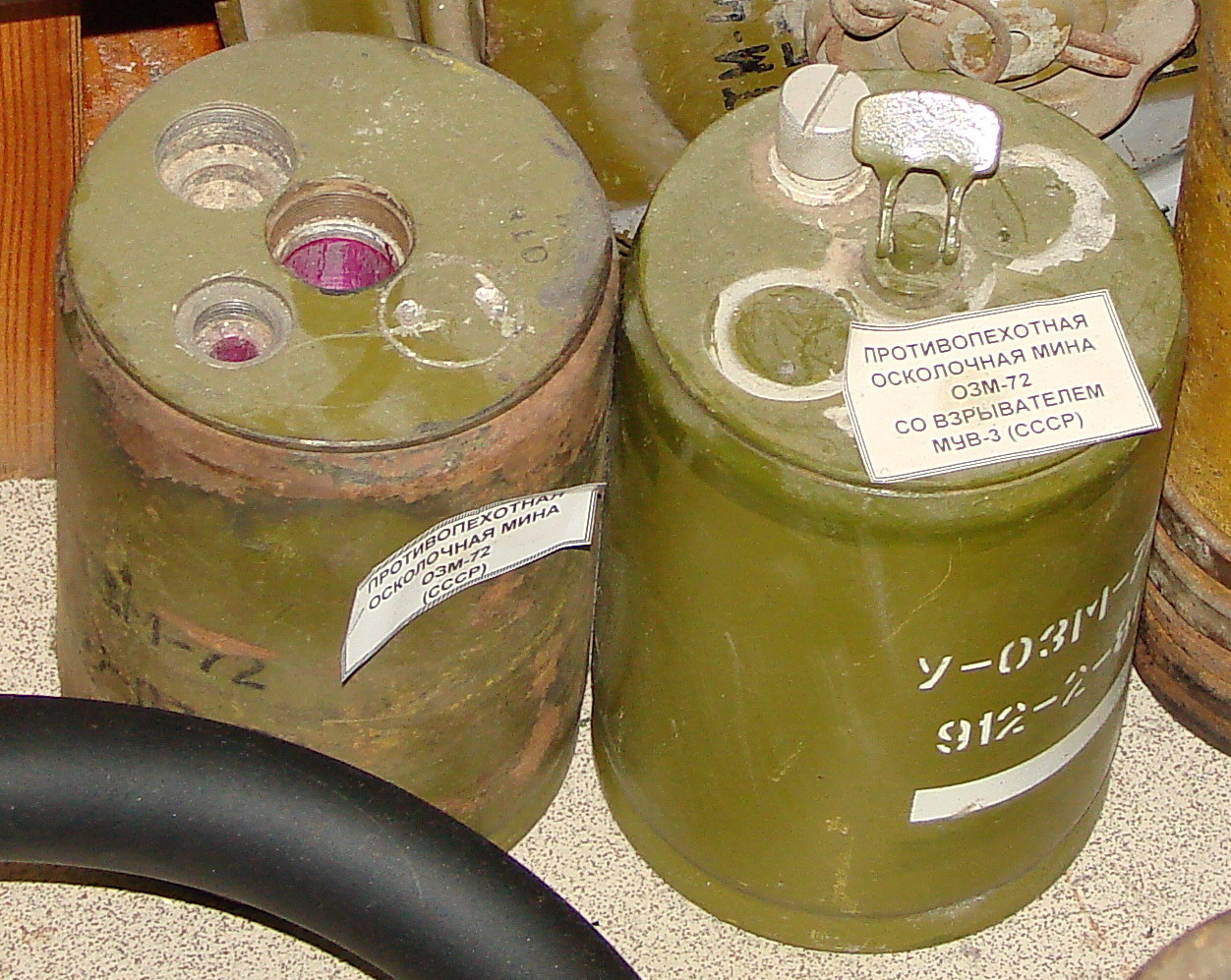OZM2 on:
[Wikipedia]
[Google]
[Amazon]
The OZM-3, OZM-4 and OZM-72 are

Soviet
The Union of Soviet Socialist Republics. (USSR), commonly known as the Soviet Union, was a List of former transcontinental countries#Since 1700, transcontinental country that spanned much of Eurasia from 1922 until Dissolution of the Soviet ...
manufactured bounding
Bounding may refer to:
* Establishing limits on the behavior of a process or device, see Listing and approval use and compliance
* Bounding overwatch, a variety of military maneuver
* A cyclical type of jumping
Jumping or leaping is a form ...
type anti-personnel mine
An anti-personnel mine or anti-personnel landmine (APL) is a form of land mine, mine designed for use against human, humans, as opposed to an anti-tank mine, which target vehicles. APLs are classified into: blast mines and fragmentation mines; ...
s.
(fragmentation-barrier mine, in the Russian and other post-Soviet armies as informally called "frog mine" or "witch" )
They are normally painted olive green, and issued with a spool of tripwires and two green painted wooden or metal stakes for affixing the tripwires. Both OZM-3 and OZM-4 have cast iron
Cast iron is a class of iron–carbon alloys with a carbon content of more than 2% and silicon content around 1–3%. Its usefulness derives from its relatively low melting temperature. The alloying elements determine the form in which its car ...
fragmenting bodies while the OZM-72 also contains preformed steel fragments, and all three are issued with empty fuze
In military munitions, a fuze (sometimes fuse) is the part of the device that initiates its function. In some applications, such as torpedoes, a fuze may be identified by function as the exploder. The relative complexity of even the earliest fu ...
wells, so a variety of fuzing options are possible.
Operation
The mines can be activated by a variety offuze
In military munitions, a fuze (sometimes fuse) is the part of the device that initiates its function. In some applications, such as torpedoes, a fuze may be identified by function as the exploder. The relative complexity of even the earliest fu ...
s, including electronic fuzes or command initiation, although they are most commonly fitted with an MUV booby trap
A booby trap is a device or setup that is intended to kill, harm or surprise a human or an animal. It is triggered by the presence or actions of the victim and sometimes has some form of bait designed to lure the victim towards it. The trap may b ...
switch which is activated by a tripwire
A tripwire is a passive triggering mechanism. Typically, a wire or cord is attached to a device for detecting or reacting to physical movement.
Military applications
Such tripwires may be attached to one or more minesespecially fragme ...
.
On firing, a metal base plate remains in the ground, while the mine body is thrown up by a small lifting charge, but remains attached to a strong wire tether. When the end of the tether is reached at a height of approximately 0.5 m, the main charge explodes and scatters fragments of the casing across a wide area.
OZM mine may sometimes be laid directly on top of an MS-3 mine. The MS-3 is an anti-handling device
An anti-handling device is an attachment to or an integral part of a landmine or other munition such as some fuze types found in general-purpose air-dropped bombs, cluster bombs and sea mines. It is designed to prevent tampering or disabling, ...
which closely resembles a PMN mine
The PMN () series of blast anti-personnel mines were designed and manufactured in the Soviet Union. They are one of the most widely used and commonly found devices during demining operations. They are sometimes nicknamed "black widow" because of ...
, except that it has a "blister" on top and operates purely as a pressure-release boobytrap
A booby trap is a device or setup that is intended to kill, harm or surprise a human or an animal. It is triggered by the presence or actions of the victim and sometimes has some form of bait designed to lure the victim towards it. The trap may b ...
. Lifting an OZM mine (without rendering safe the MS-3 placed underneath) will trigger detonation
Detonation () is a type of combustion involving a supersonic exothermic front accelerating through a medium that eventually drives a shock front propagating directly in front of it. Detonations propagate supersonically through shock waves with ...
.
Variants

OZM-3
OZM-4
OZM-72
Ottawa Treaty
Since theOttawa Treaty
The Convention on the Prohibition of the Use, Stockpiling, Production and Transfer of Anti-Personnel Mines and on their Destruction of 1997, known informally as the Ottawa Treaty, the Anti-Personnel Mine Ban Convention, or often simply the Mine ...
, a number of countries have decided to retain their OZM mines, but convert them to command detonation only by destroying all fuzes which can be indiscriminately activated – potentially by non-combatants or animals. Belarus
Belarus, officially the Republic of Belarus, is a landlocked country in Eastern Europe. It is bordered by Russia to the east and northeast, Ukraine to the south, Poland to the west, and Lithuania and Latvia to the northwest. Belarus spans an a ...
in particular has decided to keep 200,000 OZM-72.
See also
* * * * *Land mine
A land mine, or landmine, is an explosive weapon often concealed under or camouflaged on the ground, and designed to destroy or disable enemy targets as they pass over or near it. Land mines are divided into two types: anti-tank mines, wh ...
References
Anti-personnel mines Land mines of the Soviet Union {{Landmine-stub